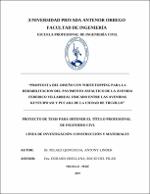Mostrar el registro sencillo del ítem
Propuesta del diseño con whitetopping para la rehabilitación del pavimento asfáltico de la avenida Federico Villareal ubicado entre las avenidas Kunturwasi y Pucara de la ciudad de Trujillo
| dc.contributor.advisor | Durand Orellana, Rocio del Pilar | |
| dc.contributor.author | Pelaez Quipuscoa, Antony Linder | |
| dc.creator | Pelaez Quipuscoa, Antony Linder | |
| dc.date.accessioned | 2019-03-27T08:28:02Z | |
| dc.date.available | 2019-03-27T08:28:02Z | |
| dc.date.issued | 2019 | |
| dc.identifier.uri | https://hdl.handle.net/20.500.12759/4654 | |
| dc.description.abstract | La presente tesis pretende dar a conocer una propuesta de rehabilitación de un pavimento flexible deteriorado, colocando un pavimento rígido sobre el pavimento existente, el que se denomina sistema “Whitetopping”, siendo una gran alternativa para las vías principales con alto volumen de tránsito y excesiva trayectoria de cargas pesadas. Este sistema no es muy conocido en el Perú y tampoco en países cercanos, por eso el desarrollo de la tesis se presentaron los procedimientos de diagnóstico y diseño de la técnica de rehabilitación a base del sistema Whitetopping. Para aplicar este diseño y convencernos de que es una gran alternativa se tomó como ejemplo una avenida pavimentada con asfalto en la Ciudad de Trujillo, el tramo fue la Avenida Federico Villarreal ubicado entre las Avenidas Kunturwasi y Pucara. Primero se hizo un diagnóstico de todo el tramo, en el que se observaron deterioros, tales como: ahuellamiento mayor de 5mm, baches, piel de cocodrilo, etc. Luego se procedió a calcular el Índice de Condición del Pavimento (PCI), para determinar el nivel de intervención. Posteriormente se hizo un estudio de tránsito vehicular y se extrajeron muestras representativas de la estructura del pavimento existente, la cuales fueron llevadas al laboratorio que está ubicada en la Universidad Nacional de Trujillo, para así obtener una excelente adherencia con la nueva carpeta de concreto (Whitetopping). Una vez obtenidos los resultados de laboratorio y estudio de tránsito, se empleó el Método de Fatiga de la Asociación de Cemento Portland (PCA), donde se logró obtener el espesor de la losa igual 18 cm. de Whitetopping, y la Norma del Ministerio de Transporte y Comunicaciones – 2013 para la dosificación adecuada de cada uno de los componentes para un concreto de 350 kg/cm 2 , siendo la dosificación Cemento : Arena Fina : Arena Gruesa : Agua , equivalente a 1: 1,16: 3,18: 0,34. La aplicación de esta técnica de rehabilitación es viable debido a su rapidez en construcción, su buen estado ante los esfuerzos y su vida útil de servicio. Palabras clave: rehabilitación, Whitetopping, pavimento, rígido. | es_PE |
| dc.description.abstract | This thesis aims to present a proposal for rehabilitation of a deteriorated flexi ble pavement, placing a rigid pavement on the existing pavement, which is called ““Whitetopping““ system, being a great alternative for the main roads with high traffic volume and excessive trajectory of heavy loads. This system is not well known in Peru or in nearby countries, so the development of the thesis presented the diagnostic procedures and design of the rehabilitation technique based on the Whitetopping system. To apply this design and convince us that it is a great alternative, we took as an exampl e an avenue paved with asphalt in the City of Trujillo, the section was Federico Villarreal Avenue located between Kunturwasi and Pucara Avenues. First a diagnosis was made of the entire section, in which deteriorations were observed, such as: rutting greater than 5mm, bumps, crocodile skin, etc. Then we proceeded to calculate the Pavement Condition Index (PCI), to determine the level of intervention. Subsequently, a vehicular traffic study was made and representative samples of the existing pavement structure were extracted, which were taken to the laboratory located in the National University of Trujillo, in order to obtain an excellent adhesion with the new concrete folder (Whitetopping). Once obtained the results of laboratory and study of transit, the Fatigue Method of the Association of Portland Cement (PCA) was used, where it was possible to obtain the thickness of the slab equal 18 cm. of Whitetopping, and the Standard of the Ministry of Transport and Communications - 2013 for the proper dosage of each of the components for a concrete of 350 kg / cm2, the dosage being Cement: Fine Sand: Coarse Sand: Water, equivalent to 1: 1.16: 3.18: 0.34. The application of this rehabilitation technique is viable due to its speed in construction, its good condition before the efforts and its service life. Keywords: rehabilitation, whitetopping, pavement, rigid. | en_US |
| dc.description.uri | Tesis | es_PE |
| dc.format | application/pdf | es_PE |
| dc.language.iso | spa | es_PE |
| dc.publisher | Universidad Privada Antenor Orrego - UPAO | es_PE |
| dc.relation.ispartofseries | T_ING.CIVIL_1684 | |
| dc.rights | info:eu-repo/semantics/closedAccess | es_PE |
| dc.source | Universidad Privada Antenor Orrego | es_PE |
| dc.source | Repositorio Institucional - UPAO | es_PE |
| dc.subject | Whitetopping | es_PE |
| dc.subject | Kunturwasi | es_PE |
| dc.title | Propuesta del diseño con whitetopping para la rehabilitación del pavimento asfáltico de la avenida Federico Villareal ubicado entre las avenidas Kunturwasi y Pucara de la ciudad de Trujillo | es_PE |
| dc.type | info:eu-repo/semantics/bachelorThesis | es_PE |
| thesis.degree.level | Título Profesional | es_PE |
| thesis.degree.grantor | Universidad Privada Antenor Orrego. Facultad de Ingeniería | es_PE |
| thesis.degree.name | Ingeniero Civil | es_PE |
| thesis.degree.discipline | Ingeniería Civil | es_PE |
Ficheros en el ítem
Este ítem aparece en la(s) siguiente(s) colección(es)
-
Ingeniería Civil [1085]

